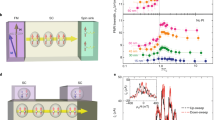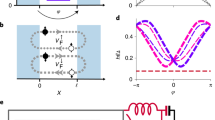Abstract
It has been proposed that high-frequency detectors based on the so-called spin-torque diode effect in spin transfer oscillators could eventually replace conventional Schottky diodes due to their nanoscale size, frequency tunability and large output sensitivity. Although a promising candidate for information and communications technology applications, the output voltage generated from this effect has still to be improved and, more pertinently, reduces drastically with decreasing radiofrequency (RF) current. Here we present a scheme for a new type of spintronics-based high-frequency detector based on the expulsion of the vortex core in a magnetic tunnel junction (MTJ). The resonant expulsion of the core leads to a large and sharp change in resistance associated with the difference in magnetoresistance between the vortex ground state and the final C-state configuration. Interestingly, this reversible effect is independent of the incoming RF current amplitude, offering a fast real-time RF threshold detector.
This is a preview of subscription content, access via your institution
Access options
Subscribe to this journal
Receive 12 print issues and online access
$259.00 per year
only $21.58 per issue
Buy this article
- Purchase on Springer Link
- Instant access to full article PDF
Prices may be subject to local taxes which are calculated during checkout




Similar content being viewed by others
References
Kiselev, S. I. et al. Microwave oscillations of a nanomagnet driven by a spin-polarized current. Nature 425, 380–383 (2003).
Chanthbouala, A. et al. Vertical-current-induced domain-wall motion in MgO-based magnetic tunnel junctions with low current densities. Nature Phys. 7, 626–630 (2011).
Pribiag, V. S. et al. Magnetic vortex oscillator driven by d.c. spin-polarized current. Nature Phys. 3, 498–503 (2007).
Dussaux, A. et al. Large microwave generation from current-driven magnetic vortex oscillators in magnetic tunnel junctions. Nature Commun. 1, 8 (2010).
Dussaux, A. et al. Field dependence of spin-transfer-induced vortex dynamics in the nonlinear regime. Phys. Rev. B 86, 014402 (2012).
Grimaldi, E. et al. Response to noise of a vortex based spin transfer nano-oscillator. Phys. Rev. B 89, 104404 (2014).
Tsunegi, S. et al. High emission power and Q factor in spin torque vortex oscillator consisting of FeB free layer. Appl. Phys. Express 7, 063009 (2014).
Sampaio, J., Cros, V., Rohart, S., Thiaville, A. & Fert, A. Nucleation, stability and current-induced motion of isolated magnetic skyrmions in nanostructures. Nature Nanotech. 8, 839–844 (2013).
Miron, I. M. et al. Perpendicular switching of a single ferromagnetic layer induced by in-plane current injection. Nature 476, 189–193 (2011).
Liu, L. et al. Spin-torque switching with the giant spin Hall effect of tantalum. Science 336, 555–558 (2012).
Tulapurkar, A. A. et al. Spin-torque diode effect in magnetic tunnel junctions. Nature 438, 339–342 (2005).
Miwa, S. et al. Highly sensitive nanoscale spin-torque diode. Nature Mater. 13, 50–56 (2014).
Zhu, J. et al. Highly sensitive nanoscale spin-torque diode. Phys. Rev. Lett. 19, 197203 (2012).
Naganuma, H. et al. Electrical detection of millimeter-waves by magnetic tunnel junctions using perpendicular magnetized l10-fepd free layer. Nano Lett. 15, 623–628 (2015).
Fang, B. et al. Giant spin-torque diode sensitivity at low input power in the absence of bias magnetic field. Preprint at http://arxiv.org/abs/1410.4958 (2014).
Guslienko, K. Y. et al. Eigenfrequencies of vortex state excitations in magnetic submicron-size disks. J. Appl. Phys. 91, 8037 (2002).
de Loubens, G. et al. Bistability of vortex core dynamics in a single perpendicularly magnetized nanodisk. Phys. Rev. Lett. 102, 177602 (2009).
Uhlir, V. et al. Dynamic switching of the spin circulation in tapered magnetic nanodisks. Nature Nanotech. 8, 341–346 (2013).
Vogel, A., Drews, A., Kamionka, T., Bolte, M. & Meier, G. Influence of dipolar interaction on vortex dynamics in arrays of ferromagnetic disks. Phys. Rev. Lett. 105, 037201 (2010).
Jenkins, A. S. et al. Controlling the chirality and polarity of vortices in magnetic tunnel junctions. Appl. Phys. Lett. 105, 172403 (2014).
Pigeau, B. et al. A frequency-controlled magnetic vortex memory. Appl. Phys. Lett. 96, 132506 (2010).
Shibata, J., Shigeto, K. & Otani, Y. Dynamics of magnetostatically coupled vortices in magnetic nanodisks. Phys. Rev. B 67, 224404 (2003).
Hanze, M., Adolff, C. F., Weigand, M. & Meier, G. Tunable eigenmodes of coupled magnetic vortex oscillators. Appl. Phys. Lett. 104, 182405 (2014).
Guslienko, K. Y., Lee, K. S. & Kim, S. K. Dynamic origin of vortex core switching in soft magnetic nanodots. Phys. Rev. Lett. 100, 027203 (2008).
Slonczewski, J. C. Current-driven excitation of magnetic multilayers. J. Magn. Magn. Mater. 159, 1–7 (1996).
Khvalkovskiy, A. V. et al. Nonuniformity of a planar polarizer for spin-transfer-induced vortex oscillations at zero field. Appl. Phys. Lett. 96, 212507 (2010).
Ivanov, B. & Zaspel, C. Excitation of spin dynamics by spin-polarized current in vortex state magnetic disks. Phys. Rev. Lett. 99, 247208 (2007).
Zhang, S. Mechanisms of spin-polarized current-driven magnetization switching. Phys. Rev. Lett. 88, 1–4 (2002).
Khvalkovskiy, A., Grollier, J., Dussaux, A., Zvezdin, K. & Cros, V. Vortex oscillations induced by spin-polarized current in a magnetic nanopillar: analytical versus micromagnetic calculations. Phys. Rev. B 80, 140401 (2009).
Lebrun, R. et al. Understanding of phase noise squeezing under fractional synchronization of a nonlinear spin transfer vortex oscillator. Phys. Rev. Lett. 115, 017201 (2015).
Donahue, M. J. & Porter, D. G. OOMMF User's Guide Version 1.0 6376 (National Institute of Standards and Technology, 1999).
Acknowledgements
The authors acknowledge the ANR agency (SPINNOVA ANR-11-NANO-0016) as well as EU FP7 grant (MOSAIC No. ICT-FP7-8.317950) for financial support. E.G. acknowledges CNES and DGA for their support.
Author information
Authors and Affiliations
Contributions
A.S.J., P.B. and V.C. conceived and coordinated the project. A.S.J. performed the experimental measurements, as well as the micromagnetic simulations. A.S.J., R.L., E.G., P.B. and V.C. interpreted the data. S.T. assisted in the development of the experimental setup. The samples were fabricated by H.K., K.Y., A.F., and S.Y. The manuscript was prepared by A.S.J. with the assistance of P.B. and V.C. All authors commented the manuscript.
Corresponding author
Ethics declarations
Competing interests
The authors declare no competing financial interests.
Supplementary information
Supplementary information
Supplementary information (PDF 544 kb)
Rights and permissions
About this article
Cite this article
Jenkins, A., Lebrun, R., Grimaldi, E. et al. Spin-torque resonant expulsion of the vortex core for an efficient radiofrequency detection scheme. Nature Nanotech 11, 360–364 (2016). https://doi.org/10.1038/nnano.2015.295
Received:
Accepted:
Published:
Issue Date:
DOI: https://doi.org/10.1038/nnano.2015.295
This article is cited by
-
Non-hermiticity in spintronics: oscillation death in coupled spintronic nano-oscillators through emerging exceptional points
Nature Communications (2024)
-
Granular vortex spin-torque nano oscillator for reservoir computing
Scientific Reports (2023)
-
Associative memory by virtual oscillator network based on single spin-torque oscillator
Scientific Reports (2023)
-
Spontaneous generation and active manipulation of real-space optical vortices
Nature (2022)
-
Non-volatile artificial synapse based on a vortex nano-oscillator
Scientific Reports (2021)



